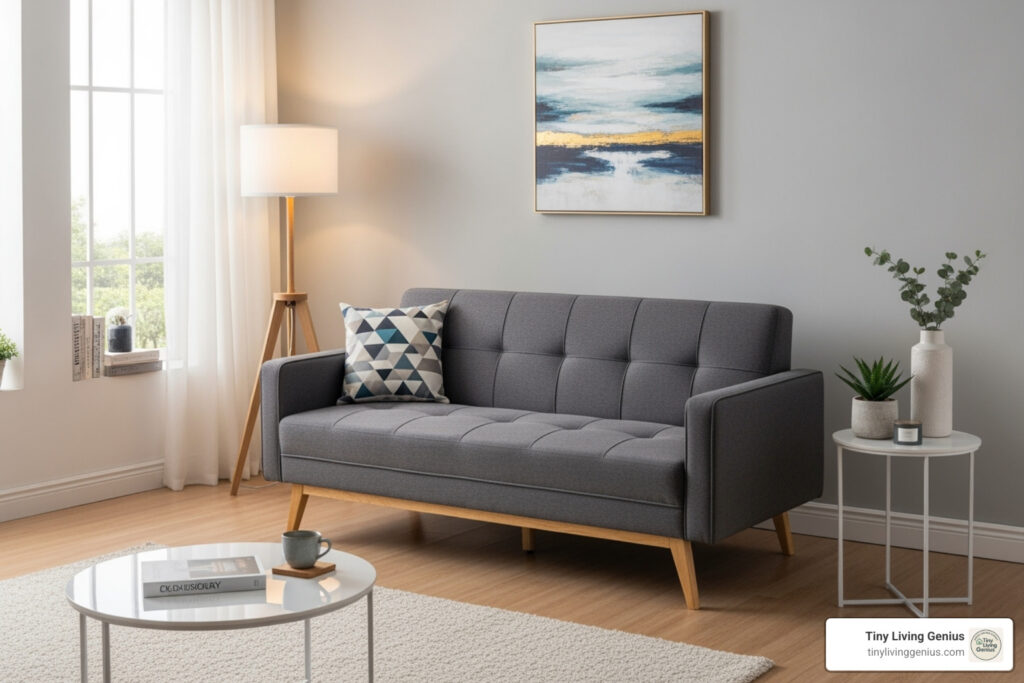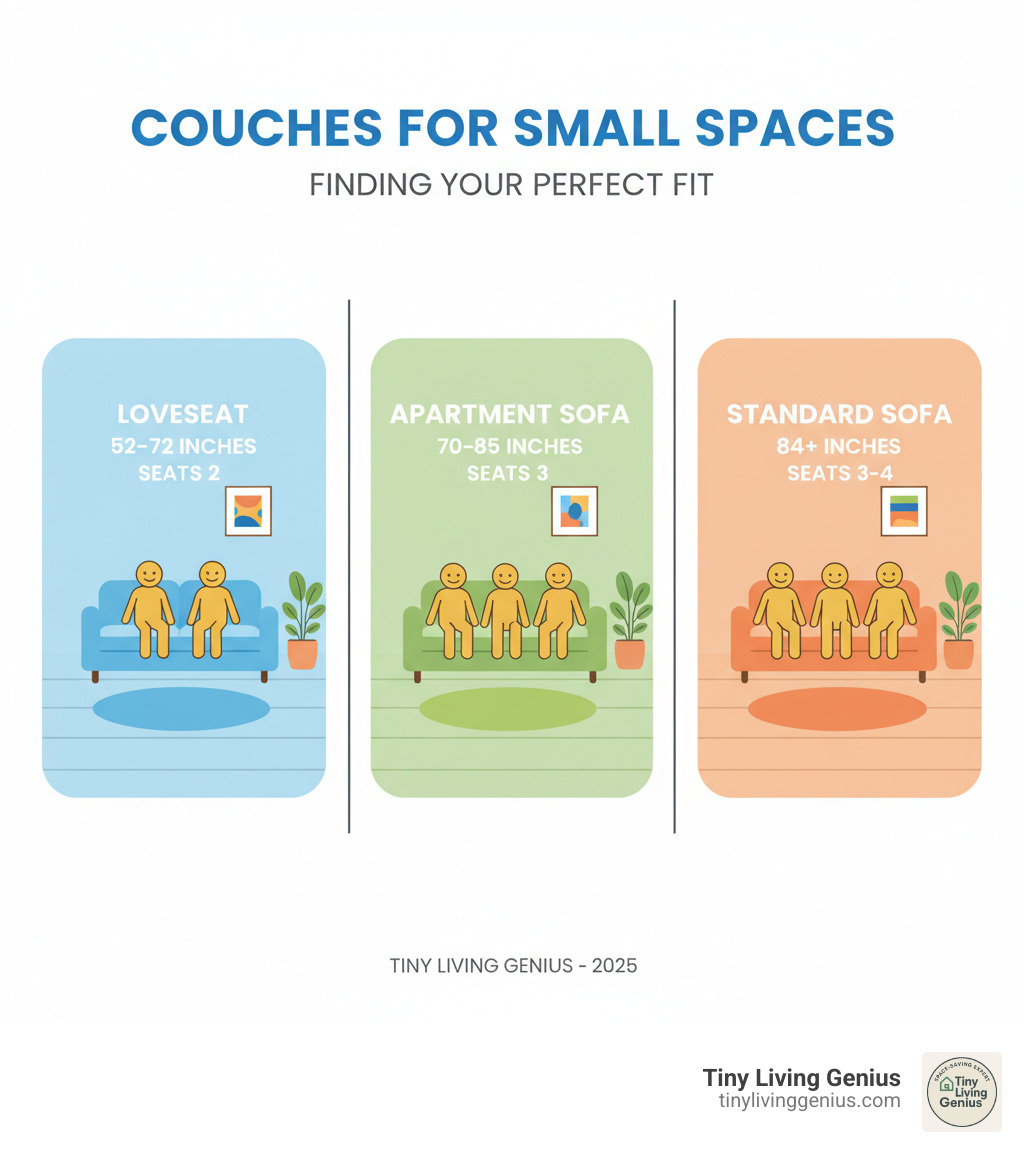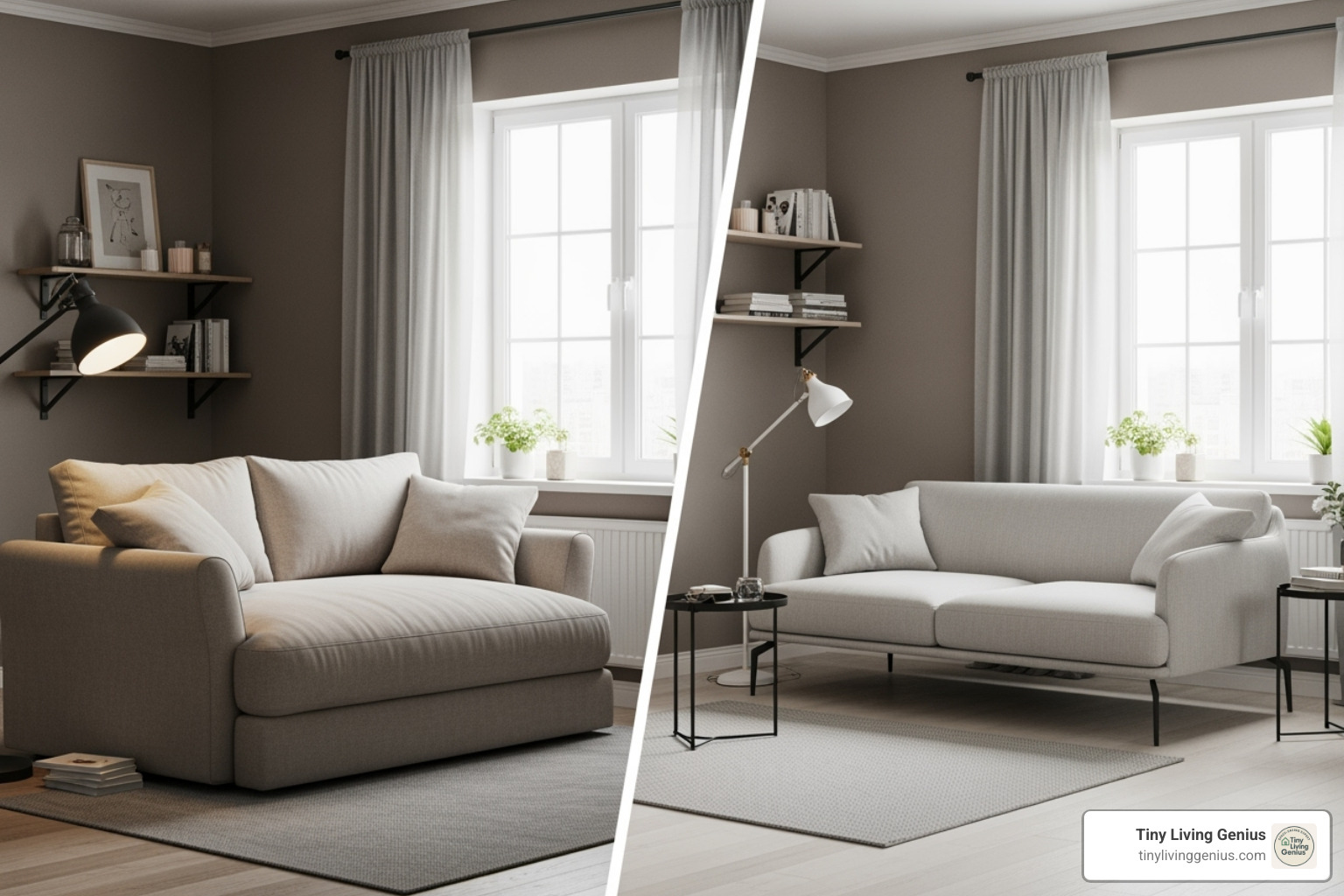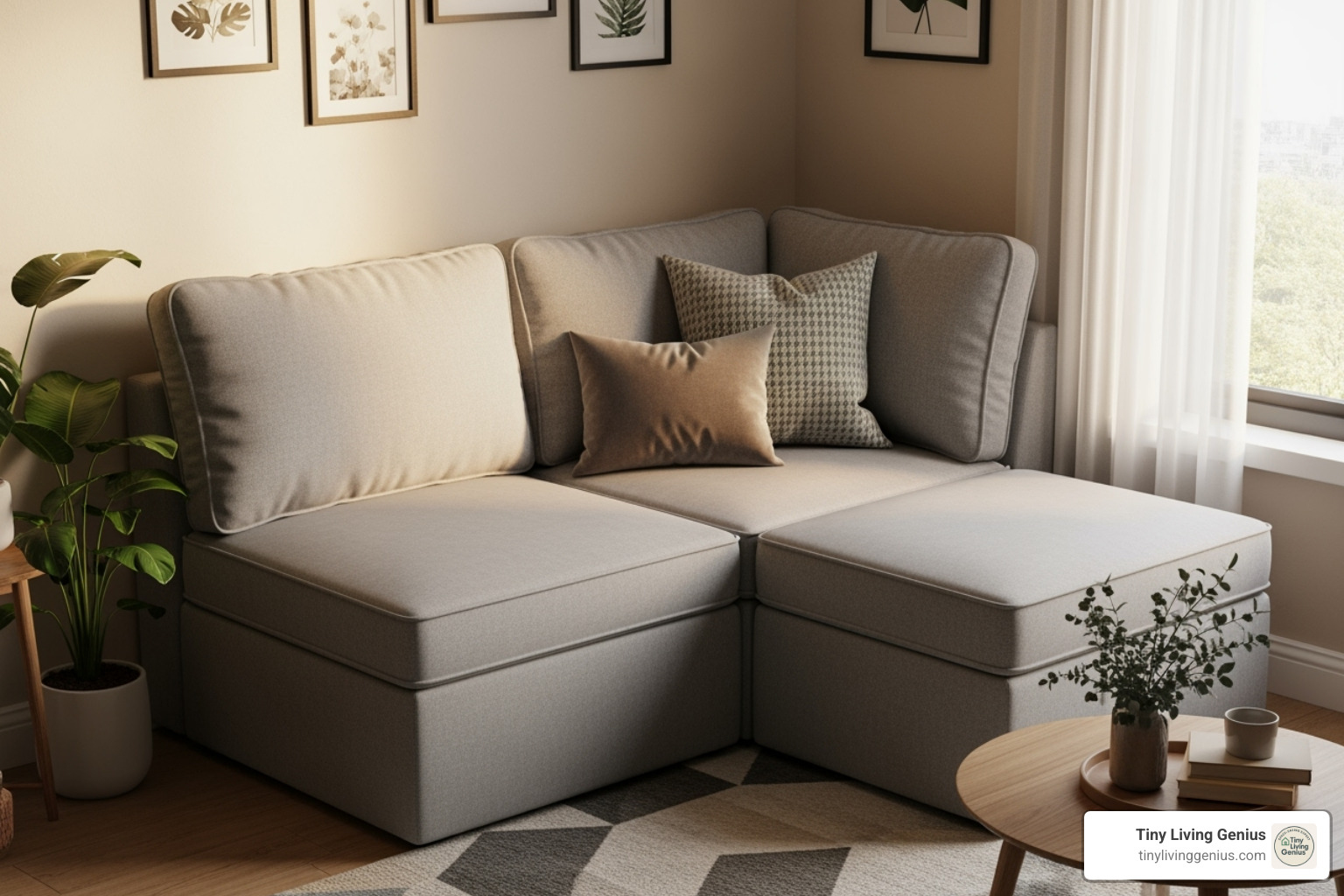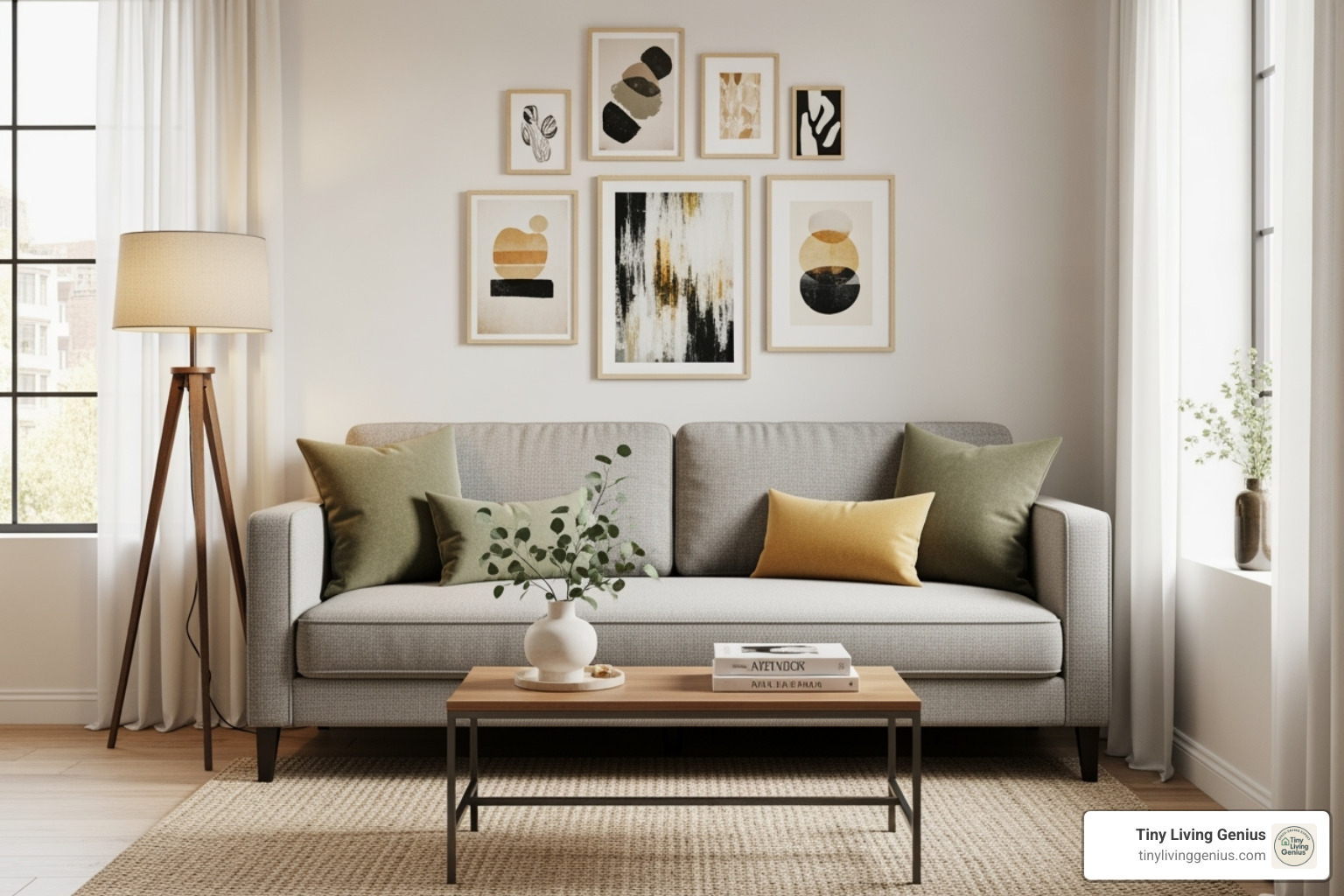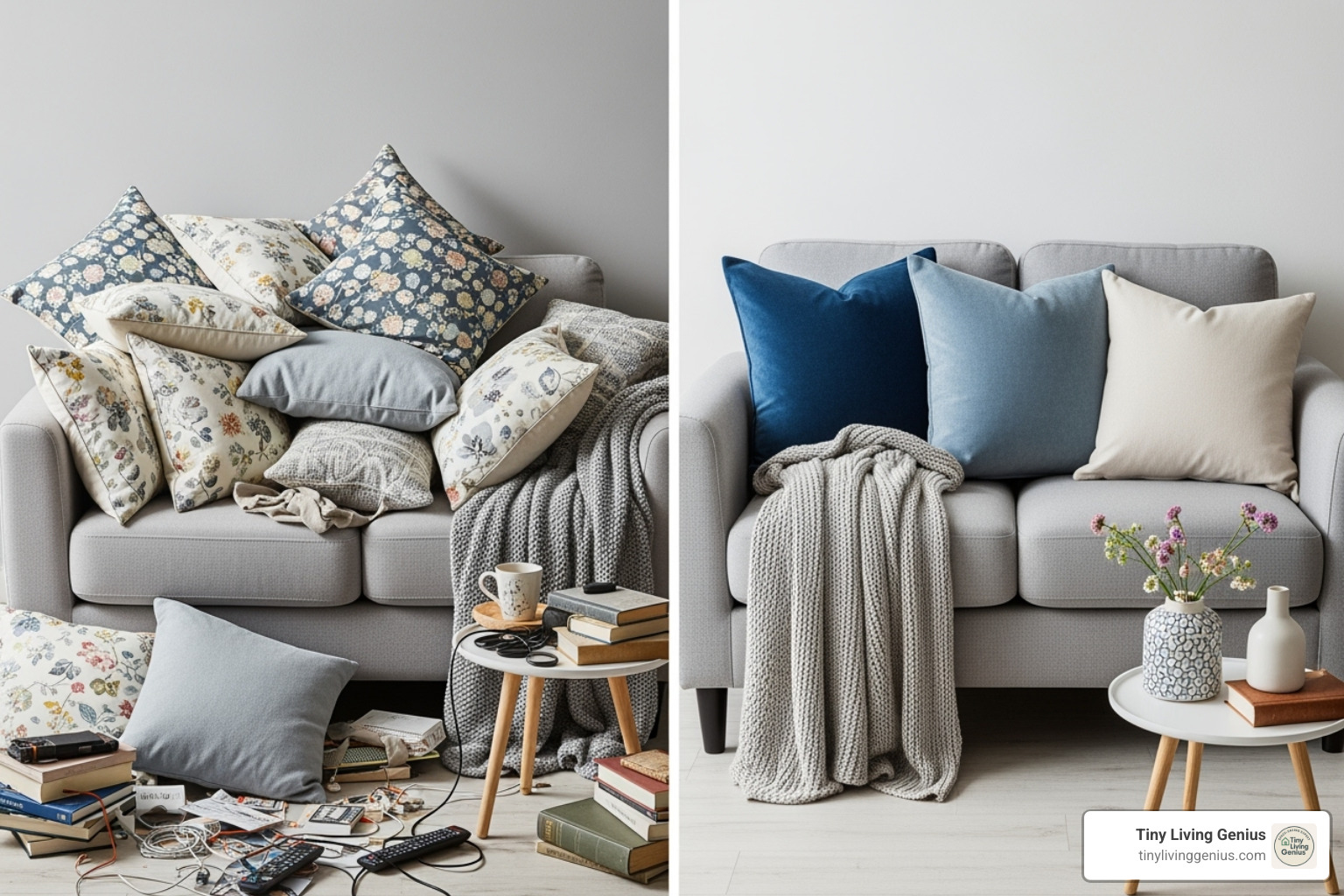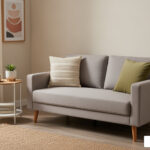Couches for Small Spaces: Ultimate Guide 2025
Finding the Perfect Couch for Your Compact Home
Couches for small spaces can make or break your tiny living room. The right one creates a cozy gathering spot that doesn’t overwhelm your space, while the wrong choice can leave you feeling cramped and frustrated.
Here are the best couch types for small spaces:
- Loveseats: 52-72 inches wide, perfect for studios and tight spaces
- Apartment-sized sofas: 70-85 inches wide, seats 3 people comfortably
- Sleeper sofas: Dual-purpose seating and guest bed functionality
- Small sectionals: L-shaped designs that maximize corner spaces
- Modular couches: Customizable pieces that adapt to your layout
As one interior design expert noted in our research, “Limited square footage doesn’t mean limited style. In fact, you have to get more creative.” The key is choosing furniture that works harder, looks great, and makes every square foot count.
The most important factors when shopping are proper measurements, visual scale, and multi-functionality. Couches between 70-74 inches wide hit the sweet spot for most small spaces, while features like exposed legs and slim arms help maintain an airy feel.
I’m Ramy Saber, a Civil Engineer and founder of Tiny Living Genius, where I’ve spent years helping people find smart couches for small spaces that maximize both comfort and style. Through extensive research and real-world testing, I’ve learned what truly works in compact homes and apartments.
How to Choose the Right Couch for Your Small Space
Choosing the right couches for small spaces is about more than just size; it’s about smart choices that improve your living area. Consider how the couch’s look, feel, and function will impact your room’s overall vibe to create a space that feels open and comfortable. For more comprehensive advice, check out The Ultimate Guide to Small Apartment Furniture: Smart Solutions for Tiny Living.
Before You Buy: The Measurement Checklist
Measuring is the most crucial step. A couch you love online is useless if it won’t fit through your door. As interior designer Shivani Vyas advises, “Start by measuring your room’s layout and architectural elements, including (but not limited to) beams, windows, fireplaces, and doors.”
Your checklist should include:
- Room Dimensions: The length and width of your room.
- Wall Space: The length of the wall where the couch will go.
- Depth Clearance: Ensure the couch won’t block walkways.
- Entryway & Hallways: Measure the width and height of all doors and hallways it must pass through, noting any tight turns.
- Stairs & Elevators: Measure the width, height, and turns of stairwells, and get your elevator’s dimensions.
Keep these measurements on your phone while shopping. A rough floor plan sketch can also help visualize the fit.
Understanding Visual Scale and Proportion
Even if a couch fits, the wrong design can make a room feel cramped. The key is choosing pieces that create a sense of spaciousness.
- Light Colors: As interior designer Kathy Kuo notes, “Sofas in warm neutral hues—like sand, beige, terra cotta, and cream—are always going to blend well into a room and make it feel bigger.” They reflect light and create an open feel.
- Exposed Legs: Legs that lift the couch off the floor create an illusion of space by allowing light to flow underneath.
- Slim Profiles: Choose couches with slim arms and low backs over bulky designs. Armless models are even better for maximizing seating area in a tight footprint.
These visual tricks make a small living room feel more inviting and spacious.
Choosing Durable Upholstery and a Solid Frame
In a small space, your couch is a workhorse, so durability is essential. Consider your lifestyle when choosing upholstery. As Gifty Walker from Joybird asks, “Who is using the furniture and how?” If you have pets, kids, or eat on the couch, you’ll need a material that can handle it.
| Material | Durability | Cleaning | Best Use Cases |
|---|---|---|---|
| Performance Fabric | Excellent: resistant to stains, fading, and wear | Easy to clean with soap and water | High-traffic areas, homes with kids and pets, rentals |
| Velvet | Good: durable but can show wear in high-traffic spots | Spot clean, professional cleaning recommended | Formal living rooms, cozy nooks, adds luxury |
| Leather | Excellent: very durable, ages well | Wipes clean, regular conditioning needed | High-traffic, homes with pets (but can scratch), modern aesthetics |
| Linen | Good: breathable, strong | Spot clean, can wrinkle, professional cleaning | Casual, airy spaces, holds up well with care |
The frame is the couch’s skeleton. Solid hardwood frames, especially kiln-dried, are the gold standard for longevity. Metal frames are also great for support, particularly in sleeper sofas. Avoid frames made of plywood or MDF if you want your couch to last. Quality construction ensures your couch will maintain its shape and support for years.
The Best Types of Couches for Small Spaces
Let’s explore the best types of couches for small spaces. The right style won’t just fit; it will transform your room without sacrificing comfort. Whether for a studio or a small living room, there’s a perfect match for you.
Compact Loveseats: The Classic Two-Seater
Loveseats are the classic choice for tight spots. Typically measuring 52 to 72 inches wide, these two-seaters provide comfortable seating without overwhelming a room. They are ideal for studio apartments or creating a cozy conversation nook.
A great example is the IKEA MORABO Loveseat ($649), which offers comfort and adaptability. Its arms can be removed to add a chaise section later, showcasing the smart design of modern small-space furniture. For more ideas, see our guide on Best Furniture Ideas for Small Spaces.
Apartment-Sized Sofas: A Little Extra Room
For a bit more room, apartment-sized sofas are the perfect middle ground. Ranging from 70 to 85 inches wide, they offer more lounging space than a loveseat without dominating the room. They comfortably seat three people.
Interior designer Jess Klein offers a pro tip: “When I’m sourcing a small sofa, I like to look at the bench cushion options first, as that style allows for more people to sit.” A bench cushion maximizes seating by eliminating dividers.
The Burrow Block Nomad Sofa ($1,359) is a great example. At 85 inches, it provides ample room to stretch out, and its modular design ensures easy delivery and assembly.
Sleeper Sofas & Futons: The Multi-Functional Marvel
Multi-functional furniture is essential for small spaces, and sleeper sofas are champions of double duty. These dual-purpose pieces transform your living room into a guest room, adding flexibility to your home.
- Sleeper sofas with pull-out bed mechanisms often hide a real mattress for maximum comfort. The Joybird Briar Sleeper Sofa ($2,159) looks like a stylish sofa but easily converts into a bed.
- Futons offer a simpler, budget-friendly fold-down design. The backrest folds flat to create a sleeping surface, and modern versions are far more stylish and comfortable than their predecessors.
Today’s sleepers are attractive couches for small spaces with a hidden superpower. For more options, see our Top 7 Foldable Sofas for Small Living Rooms.
Small Sectionals & Modular Couches: Customizable Comfort
Contrary to popular belief, sectionals can be perfect for small rooms. Small sectionals and modular couches use space efficiently, especially when placed strategically.
L-shaped sofas are great for corners, maximizing seating without cluttering the room. Many have a reversible chaise to fit any layout. The Andover Mills Campbelltown Sectional ($560) is a compact 77 inches long and includes a versatile ottoman.
Modular furniture offers ultimate adaptability. Composed of individual sections, these couches can be rearranged to suit any occasion or new apartment layout. This flexibility makes them a brilliant investment for couches for small spaces. For more innovative ideas, check out our guide to Creative Furniture Solutions for Small Spaces.
Design Tricks to Make Your Small Room Feel Larger
Once you have your perfect couches for small spaces, the right layout and styling can make your room feel even larger. These tricks create optical illusions that maximize every square foot. By creating visual flow and allowing light to move freely, any room can feel open and airy. For more strategies, see our Living Room Furniture: The Ultimate Guide to Transform Your Space.
Smart Layout and Placement Strategies
Proper furniture placement is key to creating a sense of space.
- Float your sofa: Pulling the couch a few inches from the wall creates depth and improves traffic flow.
- Use area rugs: Define zones in an open-concept space without adding bulky dividers.
- Angle your furniture: A slight angle breaks up the boxy feel of a room and creates more interesting sight lines.
- Ensure clear pathways: Leave enough room to walk comfortably around furniture to create visual breathing room.
- Choose nesting tables: These save space by tucking together when not in use, offering flexibility over a single bulky coffee table. For more brilliant furniture solutions like this, check out The Ultimate Guide to Living Room Furniture Sets: Smart Design for Every Space.
Styling Your Couch for Small Spaces
Styling is the final touch. A perfectly sized couch can still look overwhelming if styled incorrectly.
- Pillows: Use restraint. Interior designer Jess Klein suggests an asymmetrical arrangement: “My favorite way to style a small couch is with a few small pillows, arranged in three pillows on one side, and two on the other side.” Sleek lumbar pillows are also a great option.
- Throws: A neatly folded or casually draped throw adds texture and warmth without creating clutter.
- Minimalism: In small spaces, less is more. Choose a few beautiful, functional accessories rather than covering every surface.
- Cohesive Colors: A harmonious color palette for your couch, pillows, and decor creates a seamless flow that makes the room feel larger.
Thoughtful styling, combined with smart furniture choices, can transform a cramped room into a welcoming home.
Common Mistakes to Avoid When Buying a Small Couch
Shopping for couches for small spaces can be tricky, but avoiding common pitfalls is easy with a little planning. Buyer’s remorse is often the result of a few key oversights.
Here are the most common mistakes to avoid:
- Forgetting to Measure Properly: This is the biggest mistake. Measure not only your room but also all doorways, hallways, and stairs the couch must pass through.
- Ignoring Visual Scale: A couch that technically fits can still feel too big. Avoid bulky arms and low-to-the-ground designs. Opt for slim profiles, exposed legs, and light colors to make the room feel more spacious.
- Choosing the Wrong Material: Be realistic about your lifestyle. If you have pets or kids, a delicate fabric will lead to constant stress. Choose durable, easy-to-clean upholstery.
- Overlooking Multi-Functionality: In a small space, every piece of furniture should work hard. Consider sleeper sofas, modular pieces, or couches with built-in storage to maximize your square footage.
- Prioritizing Price Over Quality: A cheap, uncomfortable couch that quickly falls apart is no bargain. Invest in a solid frame and good comfort, as this piece will be heavily used.
Thinking through your actual needs—not just your wants—is the key to finding a couch that fits your room, lifestyle, and long-term happiness.
Frequently Asked Questions about Couches for Small Spaces
Here are answers to common questions about finding couches for small spaces.
Can a sectional sofa fit in a small living room?
Yes, absolutely! Look for an apartment-sized sectional. These are designed for compact living and often feature a reversible chaise for flexibility. Placing an L-shaped sectional in a corner is a brilliant strategy to maximize seating while keeping the center of your room open and eliminating awkward dead space.
What is the price range for couches for small spaces?
Prices vary widely based on size, materials, and brand. Here’s a general breakdown:
- Budget ($250-$600): You can find stylish loveseats and basic futons.
- Mid-Range ($600-$1500): This is the sweet spot for quality apartment-sized sofas and durable loveseats.
- Premium ($1500+): This range includes high-end materials, modular systems, and advanced sleeper sofas.
Investing more typically gets you better construction (like solid hardwood frames) and more durable fabrics, leading to greater comfort and longevity.
What couch colors make a room look bigger?
To make a room feel larger, choose colors that create visual lightness. Warm neutrals like sand, beige, and cream are excellent choices. As interior designer Kathy Kuo says, they “blend well into a room and make it feel bigger by not bringing in any visual distractions.”
Light gray is another versatile, modern option. The key is to select a couch color that blends with your wall color. This creates a seamless look that tricks the eye into seeing a more expansive space. Avoid dark, heavy colors, which absorb light and can make a room feel smaller.
Conclusion
Finding the perfect couches for small spaces is achievable with thoughtful choices. Remember these key takeaways:
- Measure First: It’s your insurance policy against delivery disasters. Measure your space, doorways, and hallways.
- Prioritize Visual Scale: Choose couches with exposed legs, slim arms, and light colors to create an airy, spacious feel.
- Select the Right Type: Whether it’s a compact loveseat, a versatile sleeper, or a modular sectional, pick the style that best fits your needs.
- Accept Multi-Functionality: Furniture that serves multiple purposes is a superpower in tiny living, adding flexibility and value.
- Don’t Sacrifice Comfort: A solid frame and quality upholstery are necessities, not luxuries. Your couch should be a comfortable retreat.
Your compact living room isn’t a limitation; it’s an opportunity to be creative and smart. With these insights, you’re ready to find a couch that proves great style and comfort can fit in any size home.
For more inspiration, explore our guide on Modern Furniture Designs: Maximizing Small Spaces.

